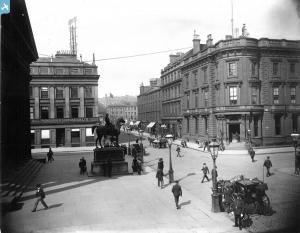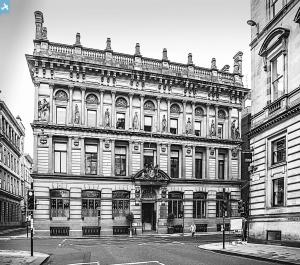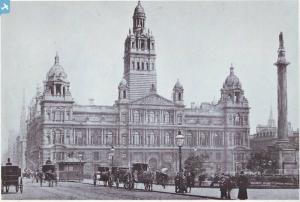 Glasgow Western Club |

navaho56 |
Wednesday 8th of May 2019 10:39:36 AM |
 Clydesdale Bank. |

navaho56 |
Wednesday 8th of May 2019 10:37:02 AM |
 Royal Technical College. |

navaho56 |
Sunday 5th of May 2019 10:00:49 AM |
 Royal Exchange Square (Arch) |

navaho56 |
Sunday 5th of May 2019 09:00:04 AM |
 Old Central Post Office. |

navaho56 |
Sunday 5th of May 2019 08:57:43 AM |
 Hutchesons Hall. |

navaho56 |
Sunday 5th of May 2019 08:56:54 AM |
 Queen Street looking North to the British Linen Bank (dome removed) |

navaho56 |
Sunday 5th of May 2019 08:17:05 AM |
 Royal Exchange Square (Arch) |

navaho56 |
Sunday 5th of May 2019 08:13:29 AM |
 Evening Citizen Building. |

navaho56 |
Sunday 5th of May 2019 08:11:33 AM |
 The Corinthian. |

navaho56 |
Sunday 5th of May 2019 08:06:32 AM |
 Royal Faculty of Procurators, |

navaho56 |
Sunday 5th of May 2019 08:03:48 AM |
 Rottenrow Maternity Hospital |

navaho56 |
Monday 15th of April 2019 11:15:18 AM |
 George Street, Glasgow Corporation Building. |

navaho56 |
Monday 15th of April 2019 08:06:05 AM |
 Church of New Jerusalem. |

navaho56 |
Monday 15th of April 2019 07:55:59 AM |
 Ingram Street looking east, St David's Parish Church (Ramshorn Kirk) on the left was designed by Thomas Rickman and his plans were substantially amended by Glasgow's Superintendent of Public Works, James Cleland. It was built in 1824-1826 to replace an earlier church, the North-West or Ramshorn, that had been built on the old lands of Ramshorn and Meadowflat in 1724. The new church became popularly known as the Ramshorn Kirk.
The Gothic church has a 120 feet tower with a large vaulted crypt that contains the earthly remains of many famous Glaswegians. The graveyard (infamously pillaged by bodysnatchers from the University during the early 1800s) was encroached upon for the widening of Ingram Street. Many graves were removed to a new graveyard at the rear of the new church, but those of the Foulis Brothers lie under the pavement near the main entrance marked with a cross and their initials A F and R F. |

navaho56 |
Thursday 4th of April 2019 03:14:32 PM |
 St George's Tron Church was designed by William Stark and built 1807-1809 on Buchanan Street facing along George Street. The square in which it stands, once called St George's Place, is now Nelson Mandela Place.
The Baroque church tower is thought to have been heavily influenced by the work of Sir Christopher Wren while the lower portion of the church's east-facing facade is influenced by Nicholas Hawksmoor. The tower is 160 feet high and the four obelisks at each corner were intially planned to be colossal statues but there were insufficient funds for the work. |

navaho56 |
Thursday 4th of April 2019 09:22:34 AM |
 St. Vincent Place. |

navaho56 |
Thursday 4th of April 2019 09:10:48 AM |
 Merchants' House corner of West George Street and George Square |

navaho56 |
Wednesday 3rd of April 2019 10:12:20 AM |
 St Vincent Pl. Anchor Line Building. |

navaho56 |
Wednesday 3rd of April 2019 10:09:15 AM |
 George Square North British Station Hotel |

navaho56 |
Tuesday 2nd of April 2019 01:04:21 PM |
 Herriot Hill Stationery & Printing Works of William Collins Sons and Co in Cathedral Street, built in 1902 and photographed just before demolition in 1978 |

navaho56 |
Tuesday 26th of March 2019 12:52:13 PM |
 Queen Street looking south to Lewis's |

navaho56 |
Tuesday 26th of March 2019 12:45:12 PM |
 Queen Street Gallery of Modern Art |

navaho56 |
Tuesday 26th of March 2019 12:36:17 PM |
 Archways in John Street. The archways connects the original Glasgow City Chambers (built 1882-1890) to the eastern wing which was added 1914-1923. Both the arch and the new wing were designed by Watson, Salmond & Gray. |

navaho56 |
Sunday 3rd of February 2019 04:45:57 PM |
 Martha Street Registry Office. |

navaho56 |
Wednesday 30th of January 2019 12:44:23 PM |
 North Hanover Street circa. 1964. |

navaho56 |
Tuesday 29th of January 2019 08:59:22 PM |
 Rottenrow Maternity Hospital |

navaho56 |
Monday 28th of January 2019 09:58:47 AM |
 Queen St looking towards Queen St station circa 1907. |

navaho56 |
Sunday 27th of January 2019 09:28:17 PM |
 Glasgow City Chambers was designed by William Young, the winner of a competition that attracted 125 entries. Lord Provost Ure laid the foundation stone on 6 October 1883 and declared the day a public holiday in the city. The building was opened by Queen Victoria in 1888.
The sheer scale and lavishness of the City Chambers was an affirmation of the city's increasing importance and wealth at the end of the 19th century. The block covers about 62,000 square feet with a quadrangle in the centre, an impressive tower (apparently inspired by Alexander "Greek" Thomson's St Vincent Street Church) and carriage entries to the north and south. The imposing western facade on George Square, seen here, is dominated by its sculptured Jubilee Pediment with an enthroned Queen Victoria gazing west across the city. There are also impressively detailed and decorated frontages on Cochrane Street to the south, John Street to the east and George Street to the north. |

navaho56 |
Saturday 26th of January 2019 10:46:56 AM |
 Cenotaph monument on the east side of George Square. Erected in remembrance of the soldiers who died during the First World War, it was designed by Sir J J Burnet in 1922 and is flanked by sculptures of lions by Ernest Gillick. The granite cenotaph is 9.7 metres tall and is described as a truncated obelisk. There is a gilded metal cross in the form of a sword on the face and below it a representation of St Mungo in front of Glasgow's coat of arms. The monument was unveiled in May 1924 by Earl Haig. |

navaho56 |
Thursday 24th of January 2019 09:15:18 PM |
 Sir Walter Scott (1771-1832), was an internationally acclaimed novelist and poet of works including Rob Roy and the Lady of the Lake. He was the first English-language author to have many contemporary readers in Europe, Australia and North America. Glasgow's was the first public monument to Sir Walter Scott anywhere in the world, 10 years ahead of the completion of Edinburgh's Scott Monument on Princes Street.
|

navaho56 |
Thursday 24th of January 2019 09:09:34 PM |
 Sir Robert Peel (1788-1850) was Prime Minister from 1834-35 and 1841-46. As Home Secretery he reformed the London police, introducing the concept of the Bobby and reformed criminal law. Not always having support from his own party, he proposed Catholic emancipation in 1829. In 1832, he became the leader of the Conservative Party. As PM he introduced financial measures to bring the country out of debt, and the last act of his government was the repeal of the Corn Laws. |

navaho56 |
Thursday 24th of January 2019 09:08:05 PM |
 Queen Victoria (1819-1901) succeeded to the throne in 1837 and first visited Glasgow in August 1849. Her great love of Scotland prompted the acquisition of Balmoral Castle as a royal residence, which she had rebuilt in 1856 and visited almost every year until her death. The monument shows the Queen seated side-saddle, holding an imperial sceptre raised in her right hand. |

navaho56 |
Thursday 24th of January 2019 09:06:37 PM |
 Prince Albert (1819-1861) married Queen Victoria in 1840 and together they purchased the Balmoral estate in 1852. The statue was erected five years after his death. At the time, it was felt that an industrial city like Glasgow should commemorate a Prince who had been influential in social welfare and the advancement of industry. There was huge debate on what form the statue should take, but the Queen expressed a strong preference for the depiction of Albert on horseback. |

navaho56 |
Thursday 24th of January 2019 09:05:45 PM |
 James Watt (1736-1819) was a Scottish inventor and mechanical engineer, born in Greenock. He designed the first economical steam engine in 1769 and patented an improved version which had a separate condenser to reduce the consumption of fuel and steam. He came up with the idea of the condenser while walking on Glasgow Green one Sunday in 1765. The unit of electrical power was named in his honour in 1882. Watt and his sculptor Chantrey were close friends and this statue, one of several in Glasgow, was said to be a great likeness to Watt. |

navaho56 |
Thursday 24th of January 2019 09:04:07 PM |
 Glasgow-born Thomas Graham (1805-1869) was a brilliant experimental chemist, who pioneered laboratory-based chemical education at Glasgow University. His studies on the diffusions of gases resulted in 'Graham's Law and his discovery of dialysis is still used in many medical facilities today. Graham founded the Chemical Society of London in 1841 and was the last person to hold the position of Master of the Mint. |

navaho56 |
Thursday 24th of January 2019 09:02:08 PM |
 Scotland's national poet, Burns (1759-1796) wrote Auld Lang Syne, My Love Is Like A Red, Red Rose and Ode to a Haggis among many others. In this statue, Burns is shown as a superior Scottish peasant in frock-coat, waistcoat and knee breeches, holding a flower in his hand, and deep in poetic contemplation. In the late 19th century there was a movement to commemorate Burns with a series of statues, beginning with the Burns Monument in Kilmarnock in 1881. |

navaho56 |
Thursday 24th of January 2019 09:00:31 PM |
 William Ewart Gladstone FRS FSS (1809 - 1898) served as Prime Minister four separate times during a political career lasting over 60 years. Despite beginning his career as a Tory and strict Anglican, he became Liberal Party leader in 1867 and was passionate about social reform. He tried unsuccessfully to secure Home Rule for Ireland during his career. He received the freedom of the City of Glasgow in 1865, and became Lord Rector of Glasgow University in 1879. |

navaho56 |
Thursday 24th of January 2019 08:59:33 PM |
 Lieutenant-General Sir John Moore, KB (1761-1809) was a British army officer brought up in the Trongate, Glasgow. He began his military career at 15 and served as captain-lieutenant in the Duke of Hamilton's regiment in America. He rose through the military ranks and earned a reputation as one of the greatest trainers of infantrymen in military history. The effectiveness of his method was shown in the Peninsular War, where he was sent in 1808 to combat Napoleon. He defeated the French army at the Battle of Corunna in 1809, but was killed by a cannon shot. |

navaho56 |
Thursday 24th of January 2019 08:57:03 PM |
 Field Marshall Lord Clyde (1792-1863), educated at the High School of Glasgow, was a British Army officer who famously commanded the Thin Red Line of the 93rd Highlanders during the Crimean War, driving back the Russians at the Battle of Balaclava. He later became Commander-in Chief of the Indian Army and was nicknamed Old Careful because of his concern for the men under his command. |

navaho56 |
Thursday 24th of January 2019 08:54:45 PM |
 James Oswald of Auchincruive (1779 - 1853) was a liberal politician. He was a leading supporter of the movement that led to the Reform Act of 1832, and became one of the first Members of Parliament for Glasgow to be elected by male voting rights. In 1841 he succeeded to the family estate at Auchincruive, to which he retired after completing his second term in parliament. The monument was financed by private subscription from friends and admirers. It was originally erected in Sandyford Place in 1856 but was moved to a more prestigious site in 1875. |

navaho56 |
Thursday 24th of January 2019 08:51:18 PM |
 Thomas Campbell (1777-1844) : Scottish poet, historian and political commentator, born in Glasgow. His successful literary career began with the Pleasures of Hope, published in 1799, and other poems he composed include The Exile Of Erin, Ye Mariners of England and Soldier's Dream. In 1826 he was elected Lord Rectorship of Glasgow University, in competition against Sir Walter Scott. Campbell is buried in the Poet's Corner of Westminster Abbey. |

navaho56 |
Thursday 24th of January 2019 08:49:55 PM |
 Dundas Street entrance to Queen Street Station |

navaho56 |
Thursday 24th of January 2019 08:37:10 PM |
 Queen Street Station |

navaho56 |
Thursday 24th of January 2019 08:34:31 PM |
 St. Vincent Place |

Class31 |
Tuesday 20th of November 2012 04:53:09 PM |
 North Frederick Street |

Class31 |
Tuesday 20th of November 2012 04:52:26 PM |
 Queen Street |

Class31 |
Tuesday 20th of November 2012 04:51:31 PM |
 Cochrane Street |

Class31 |
Tuesday 20th of November 2012 04:51:07 PM |
 John St Power Station Electricity Works |

cell |
Monday 23rd of July 2012 08:03:01 PM |




















































![[SPW019453] Glasgow, general view, showing George Square and City Chambers. An oblique aerial photograph taken facing east.](http://britainfromabove.org.uk/sites/all/libraries/aerofilms-images/public/100x100/SPW/019/SPW019453.jpg)
![[SPW019456] Glasgow, general view, showing George Square and City Chambers. An oblique aerial photograph taken facing east.](http://britainfromabove.org.uk/sites/all/libraries/aerofilms-images/public/100x100/SPW/019/SPW019456.jpg)
![[SPW019457] Glasgow, general view, showing George Square and City Chambers. An oblique aerial photograph taken facing east.](http://britainfromabove.org.uk/sites/all/libraries/aerofilms-images/public/100x100/SPW/019/SPW019457.jpg)
![[SPW019459] Glasgow, general view, showing George Square and Queen Street Station. An oblique aerial photograph taken facing north.](http://britainfromabove.org.uk/sites/all/libraries/aerofilms-images/public/100x100/SPW/019/SPW019459.jpg)
![[SPW019461] Glasgow, general view, showing George Square and City Chambers. An oblique aerial photograph taken facing east.](http://britainfromabove.org.uk/sites/all/libraries/aerofilms-images/public/100x100/SPW/019/SPW019461.jpg)
![[SAR019239] George Square Glasgow, Lanarkshire, Scotland. An oblique aerial photograph taken facing South/East.](http://britainfromabove.org.uk/sites/all/libraries/aerofilms-images/public/100x100/SAR/019/SAR019239.jpg)
![[SPW019450] Glasgow, general view, showing George Square and Queen Street Station. An oblique aerial photograph taken facing north.](http://britainfromabove.org.uk/sites/all/libraries/aerofilms-images/public/100x100/SPW/019/SPW019450.jpg)
![[SPW019451] Glasgow, general view, showing George Square and City Chambers. An oblique aerial photograph taken facing east.](http://britainfromabove.org.uk/sites/all/libraries/aerofilms-images/public/100x100/SPW/019/SPW019451.jpg)
![[SPW027202] Glasgow, general view, showing George Square, Queen Street Station and Argyle Street. An oblique aerial photograph taken facing north.](http://britainfromabove.org.uk/sites/all/libraries/aerofilms-images/public/100x100/SPW/027/SPW027202.jpg)
![[SPW019458] Glasgow, general view, showing George Square and Queen Street Station. An oblique aerial photograph taken facing north.](http://britainfromabove.org.uk/sites/all/libraries/aerofilms-images/public/100x100/SPW/019/SPW019458.jpg)
![[SPW019452] Glasgow, general view, showing George Square and Queen Street Station. An oblique aerial photograph taken facing north.](http://britainfromabove.org.uk/sites/all/libraries/aerofilms-images/public/100x100/SPW/019/SPW019452.jpg)
![[SPW019460] Glasgow, general view, showing George Square and Queen Street Station. An oblique aerial photograph taken facing north.](http://britainfromabove.org.uk/sites/all/libraries/aerofilms-images/public/100x100/SPW/019/SPW019460.jpg)
![[SPW019455] Glasgow, general view, showing George Square and Queen Street Station. An oblique aerial photograph taken facing north.](http://britainfromabove.org.uk/sites/all/libraries/aerofilms-images/public/100x100/SPW/019/SPW019455.jpg)
![[SPW019449] Glasgow, general view, showing George Square and Queen Street Station. An oblique aerial photograph taken facing north-east.](http://britainfromabove.org.uk/sites/all/libraries/aerofilms-images/public/100x100/SPW/019/SPW019449.jpg)
![[SPW035737] Glasgow, general view, showing Hope Street and Renfield Street. An oblique aerial photograph taken facing north-east. This image has been produced from a print.](http://britainfromabove.org.uk/sites/all/libraries/aerofilms-images/public/100x100/SPW/035/SPW035737.jpg)
![[SPW035738] Glasgow, general view, showing George Square and West Nile Street. An oblique aerial photograph taken facing north.](http://britainfromabove.org.uk/sites/all/libraries/aerofilms-images/public/100x100/SPW/035/SPW035738.jpg)
![[SPW027194] Glasgow, general view, showing George Square, Queen Street Station and Ingram Street. An oblique aerial photograph taken facing north-west.](http://britainfromabove.org.uk/sites/all/libraries/aerofilms-images/public/100x100/SPW/027/SPW027194.jpg)
![[SPW019464] Glasgow, general view, showing Central and Queen Street Stations. An oblique aerial photograph taken facing north-east.](http://britainfromabove.org.uk/sites/all/libraries/aerofilms-images/public/100x100/SPW/019/SPW019464.jpg)
![[SPW027193] Glasgow, general view, showing St Enoch Station, Argyle Street and George Square. An oblique aerial photograph taken facing west.](http://britainfromabove.org.uk/sites/all/libraries/aerofilms-images/public/100x100/SPW/027/SPW027193.jpg)

.jpg?itok=T_8Zcd0N)





_0.jpg?itok=zUEFoVv_)

















.jpg?itok=iFYMjq-k)



















